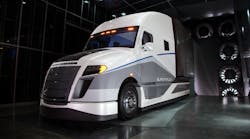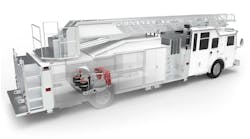There are many factors that influence the profitability of a fleet. Of these, two stand out as especially important elements: how much fuel is used and how much freight can be carried.
Fuel efficiency is more important than ever due to increased government regulation and the inevitable rise of fuel prices; and fleets that haul bulk items, such as beverages or paper, are typically limited by weight rather than by space. Fortunately, lightweighting, or reducing the weight of a vehicle or trailer for increased efficiency, can help alleviate both of these limitations.
For light and medium duty vehicles, the effects of lightweighting are generally more noticeable in increased fuel efficiency, whereas heavy duty gains are largely seen in additional weight that can be hauled.
“Fuel economy of over-the-road trucks has a lower sensitivity to weight because of the amount of service time spent running at highway speed,” say experts at Peterbilt Motors Company, a manufacturer of on-highway, vocational and heavy duty vehicles. “This is contrary to [light duty vehicles] that start and stop many times per day; the dynamics of getting up to speed is where fuel usage is high.”
Losing weight
All classes of vehicles benefit from lightweighting to some extent, both to improve fuel efficiency and increase load capacity. This is largely accomplished through substitution of traditional materials for lighter weight materials and components, but can also include reducing both the number of optional add-ons and the size of equipment.
Light and medium duty trucks
When Ford Motor Company, a U.S.-based manufacturer of cars, SUVs and light to heavy duty trucks, redesigned the F-150 half ton pickup for the 2015 model year, they used alternative materials to reduce the weight of the vehicle. They were able to “reduce the weight of the truck by about 700 pounds by using military-grade aluminum alloy and more high-strength steel,” says Tim Stoehr, Ford general fleet marketing manager.
“The weight savings contribute to enabling customers to tow more, haul more, accelerate quicker and stop shorter, all with better gas mileage,” Stoehr says.
When this combination proved effective and popular, Ford expanded it to the larger Super Duty truck for the 2017 model year, and the Expedition SUV for 2018, savings hundreds of pounds per vehicle by switching from steel to aluminum bodies.
“This weight savings enabled us to strengthen key vehicle components, including a heavier-duty fully boxed frame, axles, suspension and towing hardware, and still end up with a truck that’s 350 lbs lighter than its predecessor,” Stoehr says of the Super Duty. “As a result of the improvements, the new Super Duty can tow heavier trailers and haul more cargo than ever before, with best-in-class towing and payload capacity.”
Heavy duty trucks
Much like light and medium duty vehicle manufacturers, heavy duty manufacturers, like Navistar, have taken a comprehensive approach to lightweighting. In other words, they look at all areas of the vehicle to determine where best to remove weight. Navistar is a manufacturer of commercial trucks, buses, defense vehicles and engines.
“When we look at reducing vehicle weight, it really is a holistic approach throughout the entire vehicle,” says Jim Nachtman, product marketing director for on-highway at Navistar. “We changed the aluminum fuel tank hangers ... from iron castings to aluminum, and that saved about 55 lbs on a typical dual-tank configuration. On our International ride-optimized suspension, we changed some of the castings there to aluminum as well, and that reduced the vehicle weight by another 130 lbs, approximately. You can also look at the single-canister aftertreatment system: It’s a lot smaller system, it’s a better designed system than in the past, and that saved another 105 lbs.”
Nachtman explains that Navistar has also switched to an a la carte pricing strategy when it comes to spec’ing new trucks. With this new strategy, customers can order the options that they want instead of packages that bundle more systems or components. By selecting only the options that they want, customers can save both weight and money by choosing not to include options their fleet may not need or use.
These may seem like minor weight reductions, but with enough of them combined, the weight savings begin to add up. Nachtman adds that International’s A26 engine provides a 600- to 700-lb advantage over traditional 15L engines. The company also offers lighter weight components, such as aluminum fifth wheels, the Bendix eTrac 6x2 suspension system and the Eaton Endurant transmission, for further weight savings.
“You’re looking at about a 1,000-pound weight reduction in the base vehicle, and then another 1,000 lbs of options for additional weight reduction,” Nachtman says.
He notes that 2,000 lbs in weight reduction leads to an approximate 1 percent increase in fuel efficiency. While any increase in fuel efficiency is good, it can take a long time to recoup the additional cost of the alternative lighter weight materials at 1 percent savings. In this case, additional freight capacity is where the extra cost pays for itself relatively quickly.
“Using alternate materials to reduce weight typically comes with a cost penalty, which can be significant,” experts at Peterbilt say. “This inherently shrinks the demand for parts/systems featuring alternate materials to the weight-sensitive market such as fuel, beverage and other bulk haul customers, where the return for every pound of truck removed is increased payload.”
Trailers
Reducing weight in heavy duty trucks is a good way to increase efficiency. But, that efficiency can be increased even further by reducing the weight of the trailer. Using similar material and component replacement techniques, semitrailers can also be lightweighted to increase fuel efficiency and load capacity. Wabash National Corporation, a manufacturer of semitrailers and liquid transportation systems, uses many of these techniques to lightweight its trailers.
“Wide base tires, lightweight drums and aluminum wheels and hubs are all tried and true specifications that work in a majority of applications,” says Mark Ehrlich, director, van product line at Wabash. “Aluminum structural components, such as crossmembers, floors and roof bows can also provide a source of weight reduction depending on freight profile and duty cycle. We also offer a number of floor systems to reduce the weight of the trailer and, depending on the application, can save between 190 and 670 lbs.”
Ehrlich notes that Wabash has moved toward the use of advanced high-strength steels (AHSS) in the company’s weight reduction efforts. The use of AHSS in structural components can provide weight savings without significantly increasing cost.
Wabash also uses a material of their own, DuraPlate, to reduce the weight of their trailers. DuraPlate is a structural composite material that consists of two external steel skins thermally bonded to a high-density polyethylene core.
Maintenance and repair
In general, there are no apparent differences between traditional materials and lightweight materials when it comes to maintenance. In some cases, lightweight materials may require less maintenance. For example, aluminum does not rust whereas traditional steel does, especially when exposed to elements such as road salt.
“In general, new materials are preferred to be held to the same expectations for maintenance and serviceability as traditional materials,” Navistar’s Nachtman says. “Aluminum has the advantage, as well, that it does not corrode like steel does, so that can increase the longevity of the part, particularly in some of the corrosive environments.”
Experts at Peterbilt confirm that none of their lightweight options require special maintenance, and the same goes for Wabash’s trailers.
“There are no major changes to the preventative maintenance programs by design,” Wabash’s Ehrlich says. “In many cases, existing methods and materials used in lightweight materials will be exactly the same [as traditional materials].”
While maintenance remains about the same compared to traditional materials, lightweight materials have a reputation for being more costly to repair, since they typically require specialized equipment and training.
“To repair damage to aluminum body panels, we do recommend shops pursue training and buy the proper equipment necessary to become aluminum-repair capable,” Ford’s Stoehr says.
Stoehr advises shops may invest in the following tools and equipment, dedicated specifically to aluminum repairs to avoid cross-contamination with steel or other materials:
- Aluminum MIG welding system
- Aluminum hand and power tools
- Aluminum dent extraction system
- Aluminum Wet Mix air filtration system
- Specialized SPR rivet gun
- Work area separation/isolation system
Manufacturers are taking steps, however, to try to protect customers from undue repair costs. Designing vehicles with easily repairable or replaceable parts cuts down on repair time, and therefore repair cost.
“When we designed the all-new F-150, Super Duty and Expedition, we didn’t just swap out steel for aluminum,” Stoehr explains. “We thoughtfully redesigned the vehicles to offer our customers better performance and to make them easier to repair in the event of an accident, significantly reducing time of repair and saving costs. So, while high-strength aluminum alloy is more expensive than steel on a pound-for-pound basis, the innovative design for accident repair will significantly reduce labor time and costs as an offset.”
Stoehr notes some examples of this on the F-150:
- The apron tube can be repaired without removing the dash.
- The floorpan and rocker panels can be sectioned instead of completely replaced.
- The B-pillar can be repaired without disturbing the roof.
When it comes to heavy duty vehicles, Navistar avoids using alternative materials in some locations on the vehicle to prevent excessive repair costs for customers.
“If you look at a steel cab, for example - while steel is a traditional material, it’s a lot easier, and therefore lower cost, to repair than an aluminum cab,” Navistar’s Nachtman says.
Trailer manufacturers seem to operate under similar principles, using intelligent design to ensure repair costs for lightweight materials are similar to what they would be for traditional materials.
“Wabash National uses advanced materials, such as composites, to lightweight our trailers, but we require those materials also to be repairable,” Ehrlich says. “We work with our service shops to train them on new methods and materials.”
The future of lightweighting
Vehicle and trailer lightweighting can go a long way to boost a fleet’s bottom line. From light duty vehicles seeing significant fuel economy gains, to heavy duty vehicles that can haul significantly more freight, the results of lightweighting are overwhelmingly positive. The only downside comes with the potential for increased repair costs of these newer materials.
Manufacturers are, however, working to make it so that repair costs are on par with those of today’s traditional materials. They are also working on developing new advancements in lightweighting technology that will only lead to further improvements in fleet efficiency.
Moving forward, it is likely that vehicle weights will be further reduced as new lighter weight materials and components are developed.
As current materials and technologies become more widely used and less cost-prohibitive, fleets will only benefit from the competition between manufacturers to build the most efficient vehicles. An example of this competitive nature can be found in the SuperTruck programs currently being run by five heavy duty truck manufacturers. (See sidebar “SuperTruck superstars” for more information.)




